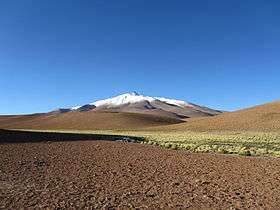Zapaleri
| Zapaleri | |
|---|---|
 | |
| Highest point | |
| Elevation | 5,653 m (18,547 ft) |
| Coordinates | 22°48′57″S 67°10′48″W / 22.81583°S 67.18000°W |
| Geography | |
 Zapaleri, right down on the map | |
| Location | Argentina-Bolivia-Chile |
| Parent range | Andes |
Zapaleri is a volcano whose summit is the tripoint of the borders of Argentina, Bolivia and Chile. A number of railways are in the area.[1] It is part of Potosí Department (Bolivia), Jujuy Province (Argentina), and Antofagasta Region (Chile). The volcano formed on top of the 2.89 mya Tara Ignimbrite from the Guacha caldera[2] and the basement beneath the volcano is formed from Cretaceous and Tertiary rocks affected by tectonic deformation. Volcanic rocks are andesite, basalt, dacite and rhyolite.[3] Late Cretaceous rocks are also found in the area,[4] as are Pleistocene shoshonite volcanic rocks.[5]
The Bolivian portion of the mountain is protected within Eduardo Avaroa Andean Fauna National Reserve. Moreover, it is close to the sector Salar de Tara-Salar de Aguas Calientes of Los Flamencos National Reserve, Chile.
Zapaleri is associated with a major source of obsidian,[6] with a distribution sphere found in archeological sites over 350 kilometres (220 mi) wide.[7] The obsidian is found on the Bolivian side of the border next to Laguna Blanca. Another source is found on Solterio Mountain.[8] Inca and earlier archeological remains are associated with the obsidian sites.[9]
References
- ↑ Benedetti, Alejandro (December 2005). "El ferrocarril Huaytiquina, entre el progreso y el fracaso. Aproximaciones desde la geografía histórica del territorio de los Andes". Revista Escuela de Historia (in Spanish). Salta: SciELO (4): 123–165. ISSN 1669-9041. Retrieved 17 January 2016.
- ↑ Ort, Michael H.; de Silva, Shanaka L.; Jiménez C., Néstor; Jicha, Brian R.; Singer, Bradley S. (January 2013). "Correlation of ignimbrites using characteristic remanent magnetization and anisotropy of magnetic susceptibility, Central Andes, Bolivia". Geochemistry, Geophysics, Geosystems. 14 (1): 141–157. doi:10.1029/2012GC004276.
- ↑ Munizaga, Francisco; Marinovic, Nicolas. "Evidencias preliminares de un volcanismo cenozoico superior en el area del Vn. Zapaleri, II Region, Chile" (PDF). SERNAGEOMIN (in Spanish). Second Chilean Geologic Congress. Archived from the original (PDF) on 25 November 2015. Retrieved 18 January 2016.
- ↑ Cretaceous Tectonics of the Andes. Wiesbaden: Vieweg+Teubner Verlag. 1994. p. 229. ISBN 978-3-322-85472-8. Retrieved 17 January 2016.
- ↑ Coira, Beatríz; Davidson, John; Mpodozis, Constantino; Ramos, Victor (November 1982). "Tectonic and magmatic evolution of the Andes of northern Argentina and Chile". Earth-Science Reviews. 18 (3-4): 303–332. doi:10.1016/0012-8252(82)90042-3.
- ↑ Latorre, Claudio; Santoro, Calogero M.; Ugalde, Paula C.; Gayo, Eugenia M.; Osorio, Daniela; Salas-Egaña, Carolina; De Pol-Holz, Ricardo; Joly, Delphine; Rech, Jason A. (October 2013). "Late Pleistocene human occupation of the hyperarid core in the Atacama Desert, northern Chile". Quaternary Science Reviews. 77: 19–30. doi:10.1016/j.quascirev.2013.06.008.
- ↑ Malainey, Mary E. (2011). A consumer's guide to archaeological science analytical techniques (1st ed.). New York: Springer. pp. 275–289. ISBN 978-1-4419-5704-7. Retrieved 17 January 2016.
- ↑ Yacobaccio, Hugo D; Escola, Patricia S; Pereyra, Fernando X; Lazzari, Marisa; Glascock, Michael D (February 2004). "Quest for ancient routes: obsidian sourcing research in Northwestern Argentina". Journal of Archaeological Science. 31 (2): 193–204. doi:10.1016/j.jas.2003.08.001.
- ↑ Seelenfreund, Andrea; Pino, Mario; Glascock, Michael D.; Sinclaire, Carole; Miranda, Pedro; Pasten, Denisse; Cancino, Simón; Dinator, María Inés; Morales, José Roberto (March 2010). "Morphological and geochemical analysis of the Laguna Blanca/Zapaleri obsidian source in the Atacama Puna". Geoarchaeology. 25 (2): 245–263. doi:10.1002/gea.20306.